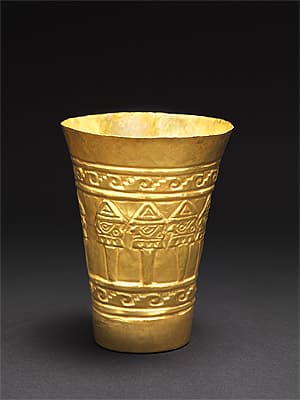SICÁN-LAMBAYEQUE culture North coast 750 – 1375 AD
Beaker 900–1100 AD gold , hammered, embossed, annealing, and repoussè13.2 (h) cm 10.0 cm (diameter) National Gallery of Australia, Canberra NGA 1986.698 Gift of American Friends of the National Gallery of Australia, Inc., New York, NY, USA, made possible with the generous support of Nora Wise in memory of her husband John Wise 1986
Members of the Sicán elite were buried with masks attached to their mummy bundles as a substitute for the face of the deceased. Additional masks, possibly worn by attendants in the afterlife, were placed within the tomb. Artificial arms and hands were laid around the body, positioned to look as though they held decorated gold beakers. The cups were stacked in columns and put in the four corners of burial chambers. As many as 200 cups have been found in one tomb.
Members of the Sicán elite were buried with masks attached to their mummy bundles as a substitute for the face of the deceased. Additional masks, possibly worn by attendants in the afterlife, were placed within the tomb. Artificial arms and hands were laid around the body, positioned to look as though they held decorated gold beakers. The cups were stacked in columns and put in the four corners of burial chambers. As many as 200 cups have been found in one tomb.
Members of the Sicán elite were buried with masks attached to their mummy bundles as a substitute for the face of the deceased. Additional masks, possibly worn by attendants in the afterlife, were placed within the tomb. Artificial arms and hands were laid around the body, positioned to look as though they held decorated gold beakers. The cups were stacked in columns and put in the four corners of burial chambers. As many as 200 cups have been found in one tomb.


